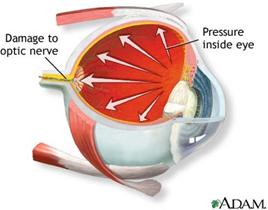We help patients
Enjoy a Lifetime of Full Vision
with minimal impact on their daily activities.
Glaucoma
Glaucoma is progressive damage to the optic nerve – the part of the eye that carries the images we see to the brain. Glaucoma is the second leading cause of blindness in the United States.

Symptoms & Diagnosis
Damage from glaucoma frequently occurs without warning signs or symptoms. More than half of people who have glaucoma don’t even realize it. By the time people have blind spots in their field of vision significant damage to the optic nerve has occurred. Early treatment can often prevent loss of sight.
Regular eye examinations by your Eye M.D. are the best way to detect glaucoma. There are five common tests for glaucoma: tonometry and ophthalmoscopy are considered more routine, but the visual field test, pachymetry and gonioscopy are also used in diagnosis. Some of these tests may not be necessary for everyone. These tests may need to be repeated on a regular basis to keep track of any changes in your condition.
Risk Factors for Glaucoma
- Age (45 years and older)
- Elevated eye pressure
- Family history of glaucoma
- African, Asian or Spanish ancestry
- Severe nearsightedness
- Past eye injuries
- Thinner central corneal thickness
Types of Glaucoma
Primary open-angle glaucoma is the most common form of glaucoma in the United States. Typically, open-angle glaucoma has no symptoms in its early stages, and vision remains normal.
Angle-closure glaucoma – Some people are born with the iris too close to the drainage angle. These eyes, which are often small and farsighted, can develop closure of the drainage angle. Since the fluid cannot exit the eye, pressure inside the eye builds rapidly and causes an acute closed-angle attack. Chronic Angle closure occurs when the drainage angle is intermittently closed resulting in progressive damage to the optic nerve.
Secondary Glaucomas – Pseudoexfoliation and Pigment Dispersion glaucomas occur when material or pigment block the drainage channel of the eye causing the intraocular pressure to increase.
Treatment
Your ophthalmologist, Eye M.D., will weigh your factors before deciding whether you need treatment. You may simply need to be monitored closely. This means your risk of developing glaucoma is higher than normal. Make sure to have regular examinations – including a baseline eye disease screening at age 40 – to detect the early signs of damage to the optic nerve.
- Medications – Daily eye drops to reduce eye pressure by reducing amount of fluid produced or improving outflow.
- Laser Trabeculoplasty – Opening up drainage channels to aid in lowering eye pressure.
- Surgery
- Minimally Invasive Glaucoma Surgery (MIGS) using devices like the IStent. The IStent provides a less invasive and safe surgical approach to glaucoma surgery. It is the smallest medical device ever implanted into humans. It functions by internally bypassing the high resistance portion of the eye’s drainage system.
- Trabeculectomy and Tube Shunts: These procedures are done to lower the pressure in the eye and prevent optic nerve damage and are usually reserved for patients who have not achieved adequate lowering of their eye pressure through medications, laser, or MIGS.
With appropriate treatment, patients can enjoy a lifetime of full vision with minimal impact on their daily activities. Contact our office to schedule an examination if you’re concerned about glaucoma.

